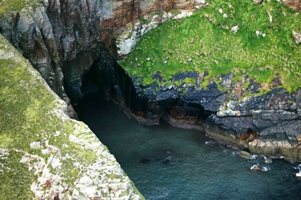| Submerged or partially submerged sea caves vary from being small, i.e., too small for an person to enter, to being large caverns 50–100 m in width that generally taper as they extend back into the shore. Where a bank of boulders is present at the back of a cave and the area is not continually submerged it may be used as a haul out area by seals. Caves usually occur on cliff faces with entrances extending above the surface of the sea but a number of caves are known to be completely under water and form tunnels or caverns some of which may have both underwater openings and small surface openings. Caves are known to extend up to 1.5 km. |  |
| Their distribution in Ireland has not been systematically mapped with the exception of the cave system at Doolin, Co. Clare. A limited amount of information is available from the SCUBA diving community and 23 caves, a number of which are completely under water, have been identified from Hook Head in Co. Wexford to Malin Head, Co. Donegal and all known caves occur within 1 km of the coastline. | Above and Below: Sea Caves (Photo: NPWS) |
| The floor of caves varies from being a sediment floor to bedrock and or boulders. Frequently the sides of caves are devoid of fauna close to the floor due to sediment or boulder scour. Where boulder/sediment scour is intense, the cave may have very limited fauna. Two caves were surveyed by the BioMar Project and the species found on the walls and roofs support a community that is typical of steeply sloping rock or overhangs. The walls and roofs are generally densely covered in encrusting sponges including Leuconia nivea, Clathrina coriacea, Dysidea fragilis and Dercitus bucklandi, which is characteristic of caves and crevices. Other species recorded included the hydroid, Tubularia indivisa, anthozoans Corynactic virids and Phellia gausapata, bryozoans Crisia spp. and Scrupocellaria reptans, the sea squirt Dendrodoa grossulariaand encrusting coralline algae. All species recorded to date are not specific to caves and are widely distributed occurring on steeply sloping to vertical bedrock in a high energy zones. |  |
